(Doc) Assignment: Entrepreneurship and Small Business Management
VerifiedAdded on 2021/02/19
|12
|4005
|28
AI Summary
Contribute Materials
Your contribution can guide someone’s learning journey. Share your
documents today.
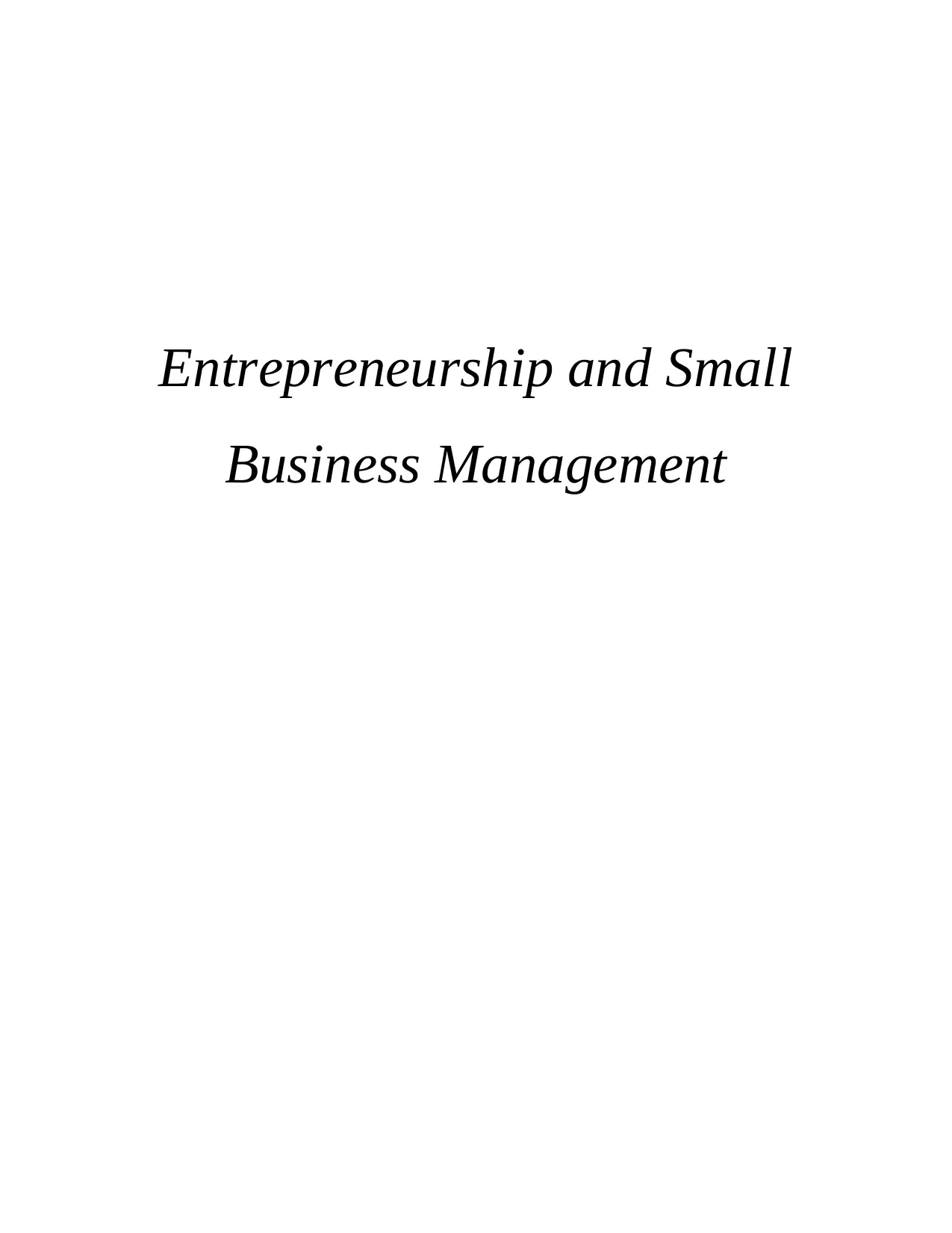
Entrepreneurship and Small
Business Management
Business Management
Secure Best Marks with AI Grader
Need help grading? Try our AI Grader for instant feedback on your assignments.
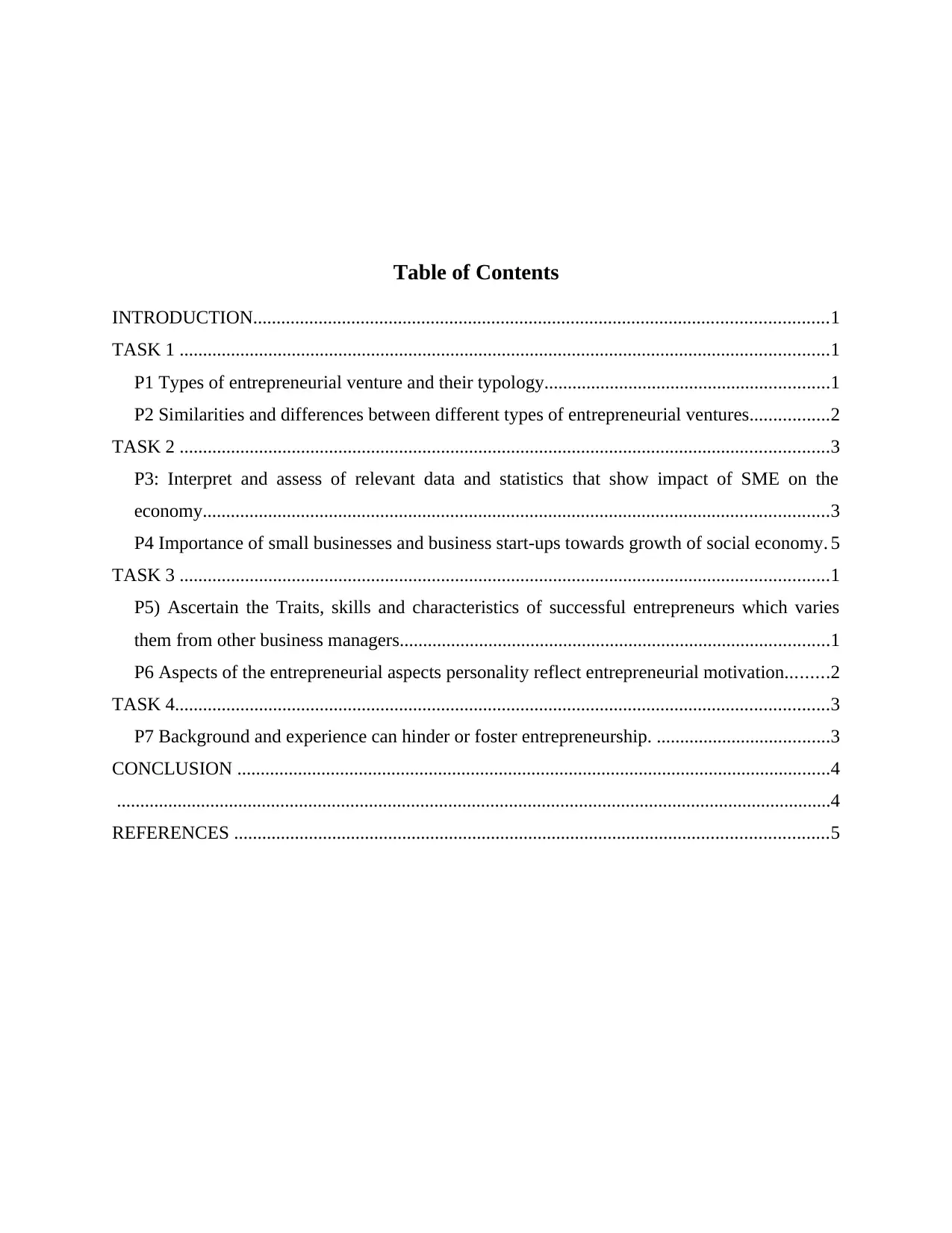
Table of Contents
INTRODUCTION...........................................................................................................................1
TASK 1 ...........................................................................................................................................1
P1 Types of entrepreneurial venture and their typology.............................................................1
P2 Similarities and differences between different types of entrepreneurial ventures.................2
TASK 2 ...........................................................................................................................................3
P3: Interpret and assess of relevant data and statistics that show impact of SME on the
economy......................................................................................................................................3
P4 Importance of small businesses and business start-ups towards growth of social economy. 5
TASK 3 ...........................................................................................................................................1
P5) Ascertain the Traits, skills and characteristics of successful entrepreneurs which varies
them from other business managers............................................................................................1
P6 Aspects of the entrepreneurial aspects personality reflect entrepreneurial motivation.........2
TASK 4............................................................................................................................................3
P7 Background and experience can hinder or foster entrepreneurship. .....................................3
CONCLUSION ...............................................................................................................................4
.........................................................................................................................................................4
REFERENCES ...............................................................................................................................5
INTRODUCTION...........................................................................................................................1
TASK 1 ...........................................................................................................................................1
P1 Types of entrepreneurial venture and their typology.............................................................1
P2 Similarities and differences between different types of entrepreneurial ventures.................2
TASK 2 ...........................................................................................................................................3
P3: Interpret and assess of relevant data and statistics that show impact of SME on the
economy......................................................................................................................................3
P4 Importance of small businesses and business start-ups towards growth of social economy. 5
TASK 3 ...........................................................................................................................................1
P5) Ascertain the Traits, skills and characteristics of successful entrepreneurs which varies
them from other business managers............................................................................................1
P6 Aspects of the entrepreneurial aspects personality reflect entrepreneurial motivation.........2
TASK 4............................................................................................................................................3
P7 Background and experience can hinder or foster entrepreneurship. .....................................3
CONCLUSION ...............................................................................................................................4
.........................................................................................................................................................4
REFERENCES ...............................................................................................................................5
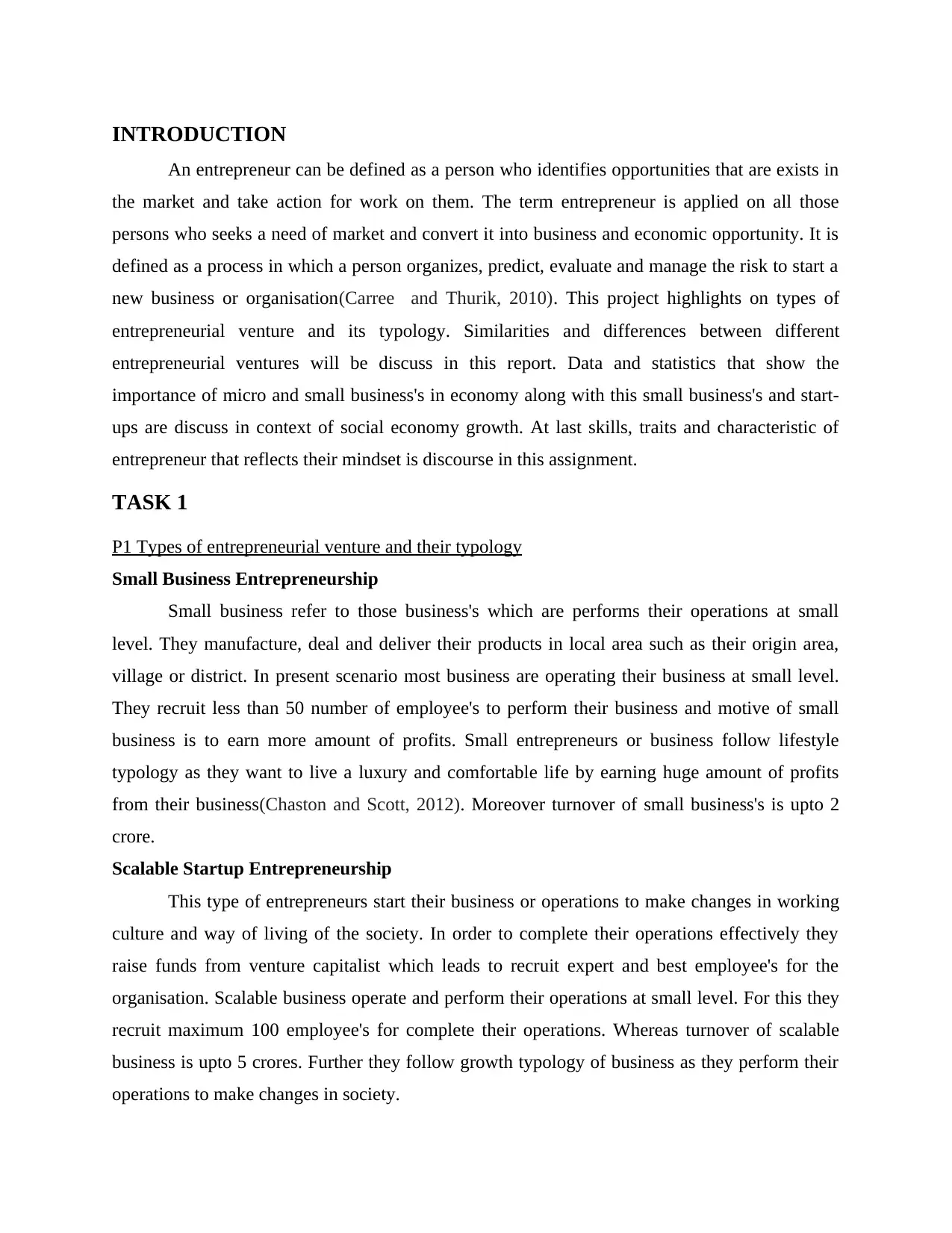
INTRODUCTION
An entrepreneur can be defined as a person who identifies opportunities that are exists in
the market and take action for work on them. The term entrepreneur is applied on all those
persons who seeks a need of market and convert it into business and economic opportunity. It is
defined as a process in which a person organizes, predict, evaluate and manage the risk to start a
new business or organisation(Carree and Thurik, 2010). This project highlights on types of
entrepreneurial venture and its typology. Similarities and differences between different
entrepreneurial ventures will be discuss in this report. Data and statistics that show the
importance of micro and small business's in economy along with this small business's and start-
ups are discuss in context of social economy growth. At last skills, traits and characteristic of
entrepreneur that reflects their mindset is discourse in this assignment.
TASK 1
P1 Types of entrepreneurial venture and their typology
Small Business Entrepreneurship
Small business refer to those business's which are performs their operations at small
level. They manufacture, deal and deliver their products in local area such as their origin area,
village or district. In present scenario most business are operating their business at small level.
They recruit less than 50 number of employee's to perform their business and motive of small
business is to earn more amount of profits. Small entrepreneurs or business follow lifestyle
typology as they want to live a luxury and comfortable life by earning huge amount of profits
from their business(Chaston and Scott, 2012). Moreover turnover of small business's is upto 2
crore.
Scalable Startup Entrepreneurship
This type of entrepreneurs start their business or operations to make changes in working
culture and way of living of the society. In order to complete their operations effectively they
raise funds from venture capitalist which leads to recruit expert and best employee's for the
organisation. Scalable business operate and perform their operations at small level. For this they
recruit maximum 100 employee's for complete their operations. Whereas turnover of scalable
business is upto 5 crores. Further they follow growth typology of business as they perform their
operations to make changes in society.
An entrepreneur can be defined as a person who identifies opportunities that are exists in
the market and take action for work on them. The term entrepreneur is applied on all those
persons who seeks a need of market and convert it into business and economic opportunity. It is
defined as a process in which a person organizes, predict, evaluate and manage the risk to start a
new business or organisation(Carree and Thurik, 2010). This project highlights on types of
entrepreneurial venture and its typology. Similarities and differences between different
entrepreneurial ventures will be discuss in this report. Data and statistics that show the
importance of micro and small business's in economy along with this small business's and start-
ups are discuss in context of social economy growth. At last skills, traits and characteristic of
entrepreneur that reflects their mindset is discourse in this assignment.
TASK 1
P1 Types of entrepreneurial venture and their typology
Small Business Entrepreneurship
Small business refer to those business's which are performs their operations at small
level. They manufacture, deal and deliver their products in local area such as their origin area,
village or district. In present scenario most business are operating their business at small level.
They recruit less than 50 number of employee's to perform their business and motive of small
business is to earn more amount of profits. Small entrepreneurs or business follow lifestyle
typology as they want to live a luxury and comfortable life by earning huge amount of profits
from their business(Chaston and Scott, 2012). Moreover turnover of small business's is upto 2
crore.
Scalable Startup Entrepreneurship
This type of entrepreneurs start their business or operations to make changes in working
culture and way of living of the society. In order to complete their operations effectively they
raise funds from venture capitalist which leads to recruit expert and best employee's for the
organisation. Scalable business operate and perform their operations at small level. For this they
recruit maximum 100 employee's for complete their operations. Whereas turnover of scalable
business is upto 5 crores. Further they follow growth typology of business as they perform their
operations to make changes in society.
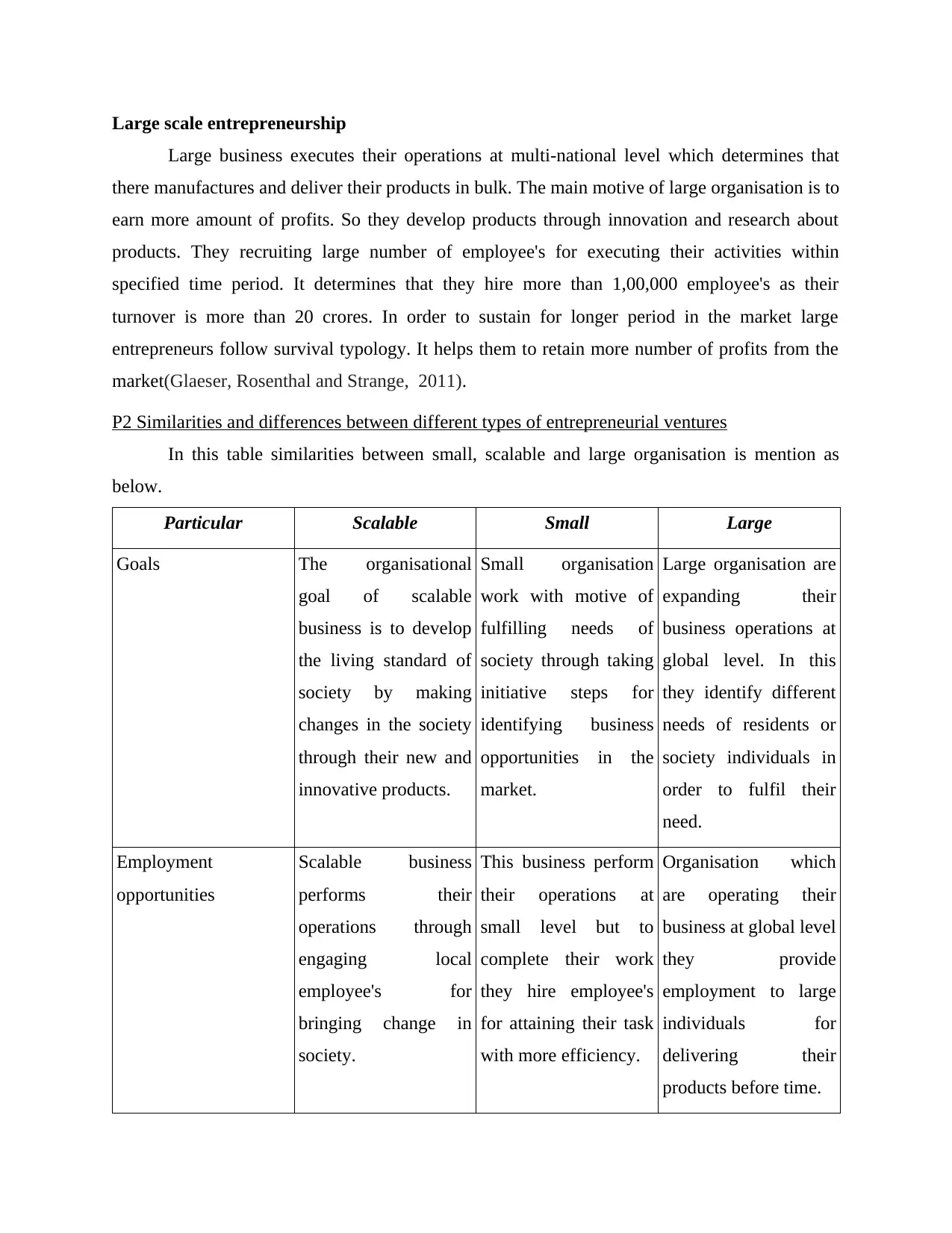
Large scale entrepreneurship
Large business executes their operations at multi-national level which determines that
there manufactures and deliver their products in bulk. The main motive of large organisation is to
earn more amount of profits. So they develop products through innovation and research about
products. They recruiting large number of employee's for executing their activities within
specified time period. It determines that they hire more than 1,00,000 employee's as their
turnover is more than 20 crores. In order to sustain for longer period in the market large
entrepreneurs follow survival typology. It helps them to retain more number of profits from the
market(Glaeser, Rosenthal and Strange, 2011).
P2 Similarities and differences between different types of entrepreneurial ventures
In this table similarities between small, scalable and large organisation is mention as
below.
Particular Scalable Small Large
Goals The organisational
goal of scalable
business is to develop
the living standard of
society by making
changes in the society
through their new and
innovative products.
Small organisation
work with motive of
fulfilling needs of
society through taking
initiative steps for
identifying business
opportunities in the
market.
Large organisation are
expanding their
business operations at
global level. In this
they identify different
needs of residents or
society individuals in
order to fulfil their
need.
Employment
opportunities
Scalable business
performs their
operations through
engaging local
employee's for
bringing change in
society.
This business perform
their operations at
small level but to
complete their work
they hire employee's
for attaining their task
with more efficiency.
Organisation which
are operating their
business at global level
they provide
employment to large
individuals for
delivering their
products before time.
Large business executes their operations at multi-national level which determines that
there manufactures and deliver their products in bulk. The main motive of large organisation is to
earn more amount of profits. So they develop products through innovation and research about
products. They recruiting large number of employee's for executing their activities within
specified time period. It determines that they hire more than 1,00,000 employee's as their
turnover is more than 20 crores. In order to sustain for longer period in the market large
entrepreneurs follow survival typology. It helps them to retain more number of profits from the
market(Glaeser, Rosenthal and Strange, 2011).
P2 Similarities and differences between different types of entrepreneurial ventures
In this table similarities between small, scalable and large organisation is mention as
below.
Particular Scalable Small Large
Goals The organisational
goal of scalable
business is to develop
the living standard of
society by making
changes in the society
through their new and
innovative products.
Small organisation
work with motive of
fulfilling needs of
society through taking
initiative steps for
identifying business
opportunities in the
market.
Large organisation are
expanding their
business operations at
global level. In this
they identify different
needs of residents or
society individuals in
order to fulfil their
need.
Employment
opportunities
Scalable business
performs their
operations through
engaging local
employee's for
bringing change in
society.
This business perform
their operations at
small level but to
complete their work
they hire employee's
for attaining their task
with more efficiency.
Organisation which
are operating their
business at global level
they provide
employment to large
individuals for
delivering their
products before time.
Secure Best Marks with AI Grader
Need help grading? Try our AI Grader for instant feedback on your assignments.
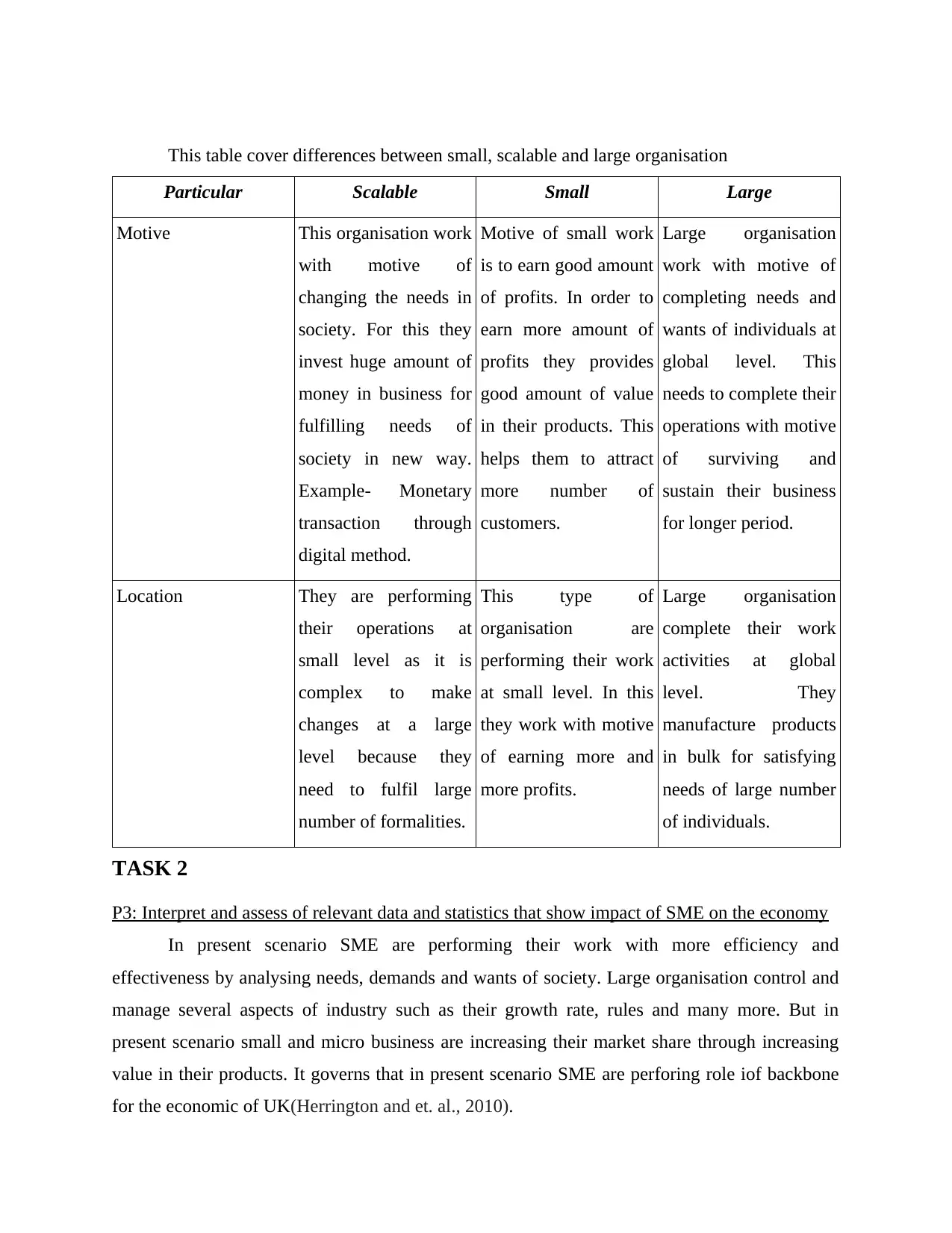
This table cover differences between small, scalable and large organisation
Particular Scalable Small Large
Motive This organisation work
with motive of
changing the needs in
society. For this they
invest huge amount of
money in business for
fulfilling needs of
society in new way.
Example- Monetary
transaction through
digital method.
Motive of small work
is to earn good amount
of profits. In order to
earn more amount of
profits they provides
good amount of value
in their products. This
helps them to attract
more number of
customers.
Large organisation
work with motive of
completing needs and
wants of individuals at
global level. This
needs to complete their
operations with motive
of surviving and
sustain their business
for longer period.
Location They are performing
their operations at
small level as it is
complex to make
changes at a large
level because they
need to fulfil large
number of formalities.
This type of
organisation are
performing their work
at small level. In this
they work with motive
of earning more and
more profits.
Large organisation
complete their work
activities at global
level. They
manufacture products
in bulk for satisfying
needs of large number
of individuals.
TASK 2
P3: Interpret and assess of relevant data and statistics that show impact of SME on the economy
In present scenario SME are performing their work with more efficiency and
effectiveness by analysing needs, demands and wants of society. Large organisation control and
manage several aspects of industry such as their growth rate, rules and many more. But in
present scenario small and micro business are increasing their market share through increasing
value in their products. It governs that in present scenario SME are perforing role iof backbone
for the economic of UK(Herrington and et. al., 2010).
Particular Scalable Small Large
Motive This organisation work
with motive of
changing the needs in
society. For this they
invest huge amount of
money in business for
fulfilling needs of
society in new way.
Example- Monetary
transaction through
digital method.
Motive of small work
is to earn good amount
of profits. In order to
earn more amount of
profits they provides
good amount of value
in their products. This
helps them to attract
more number of
customers.
Large organisation
work with motive of
completing needs and
wants of individuals at
global level. This
needs to complete their
operations with motive
of surviving and
sustain their business
for longer period.
Location They are performing
their operations at
small level as it is
complex to make
changes at a large
level because they
need to fulfil large
number of formalities.
This type of
organisation are
performing their work
at small level. In this
they work with motive
of earning more and
more profits.
Large organisation
complete their work
activities at global
level. They
manufacture products
in bulk for satisfying
needs of large number
of individuals.
TASK 2
P3: Interpret and assess of relevant data and statistics that show impact of SME on the economy
In present scenario SME are performing their work with more efficiency and
effectiveness by analysing needs, demands and wants of society. Large organisation control and
manage several aspects of industry such as their growth rate, rules and many more. But in
present scenario small and micro business are increasing their market share through increasing
value in their products. It governs that in present scenario SME are perforing role iof backbone
for the economic of UK(Herrington and et. al., 2010).
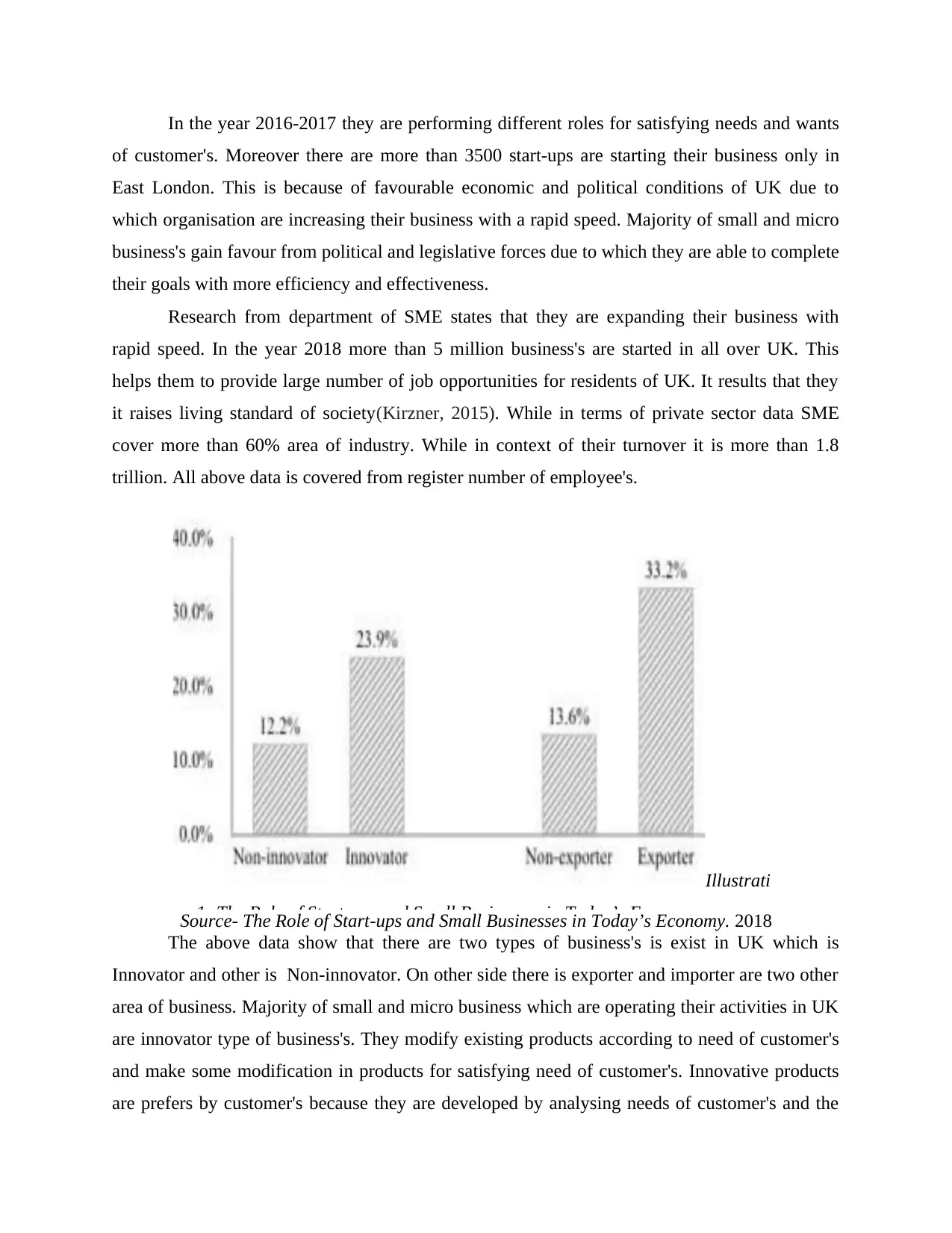
In the year 2016-2017 they are performing different roles for satisfying needs and wants
of customer's. Moreover there are more than 3500 start-ups are starting their business only in
East London. This is because of favourable economic and political conditions of UK due to
which organisation are increasing their business with a rapid speed. Majority of small and micro
business's gain favour from political and legislative forces due to which they are able to complete
their goals with more efficiency and effectiveness.
Research from department of SME states that they are expanding their business with
rapid speed. In the year 2018 more than 5 million business's are started in all over UK. This
helps them to provide large number of job opportunities for residents of UK. It results that they
it raises living standard of society(Kirzner, 2015). While in terms of private sector data SME
cover more than 60% area of industry. While in context of their turnover it is more than 1.8
trillion. All above data is covered from register number of employee's.
Source- The Role of Start-ups and Small Businesses in Today’s Economy. 2018
The above data show that there are two types of business's is exist in UK which is
Innovator and other is Non-innovator. On other side there is exporter and importer are two other
area of business. Majority of small and micro business which are operating their activities in UK
are innovator type of business's. They modify existing products according to need of customer's
and make some modification in products for satisfying need of customer's. Innovative products
are prefers by customer's because they are developed by analysing needs of customer's and the
Illustrati
on 1: The Role of Start-ups and Small Businesses in Today’s Economy
of customer's. Moreover there are more than 3500 start-ups are starting their business only in
East London. This is because of favourable economic and political conditions of UK due to
which organisation are increasing their business with a rapid speed. Majority of small and micro
business's gain favour from political and legislative forces due to which they are able to complete
their goals with more efficiency and effectiveness.
Research from department of SME states that they are expanding their business with
rapid speed. In the year 2018 more than 5 million business's are started in all over UK. This
helps them to provide large number of job opportunities for residents of UK. It results that they
it raises living standard of society(Kirzner, 2015). While in terms of private sector data SME
cover more than 60% area of industry. While in context of their turnover it is more than 1.8
trillion. All above data is covered from register number of employee's.
Source- The Role of Start-ups and Small Businesses in Today’s Economy. 2018
The above data show that there are two types of business's is exist in UK which is
Innovator and other is Non-innovator. On other side there is exporter and importer are two other
area of business. Majority of small and micro business which are operating their activities in UK
are innovator type of business's. They modify existing products according to need of customer's
and make some modification in products for satisfying need of customer's. Innovative products
are prefers by customer's because they are developed by analysing needs of customer's and the
Illustrati
on 1: The Role of Start-ups and Small Businesses in Today’s Economy
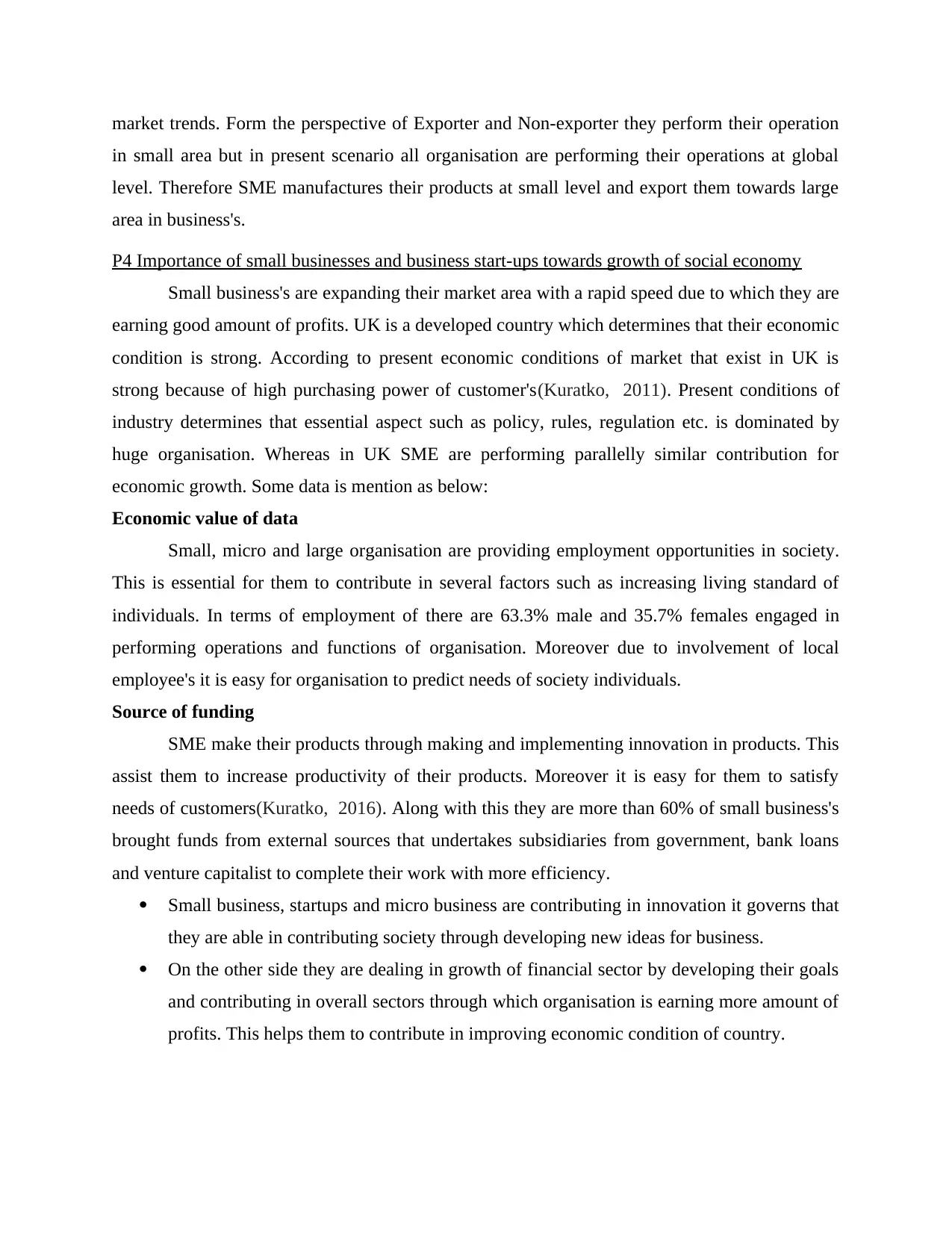
market trends. Form the perspective of Exporter and Non-exporter they perform their operation
in small area but in present scenario all organisation are performing their operations at global
level. Therefore SME manufactures their products at small level and export them towards large
area in business's.
P4 Importance of small businesses and business start-ups towards growth of social economy
Small business's are expanding their market area with a rapid speed due to which they are
earning good amount of profits. UK is a developed country which determines that their economic
condition is strong. According to present economic conditions of market that exist in UK is
strong because of high purchasing power of customer's(Kuratko, 2011). Present conditions of
industry determines that essential aspect such as policy, rules, regulation etc. is dominated by
huge organisation. Whereas in UK SME are performing parallelly similar contribution for
economic growth. Some data is mention as below:
Economic value of data
Small, micro and large organisation are providing employment opportunities in society.
This is essential for them to contribute in several factors such as increasing living standard of
individuals. In terms of employment of there are 63.3% male and 35.7% females engaged in
performing operations and functions of organisation. Moreover due to involvement of local
employee's it is easy for organisation to predict needs of society individuals.
Source of funding
SME make their products through making and implementing innovation in products. This
assist them to increase productivity of their products. Moreover it is easy for them to satisfy
needs of customers(Kuratko, 2016). Along with this they are more than 60% of small business's
brought funds from external sources that undertakes subsidiaries from government, bank loans
and venture capitalist to complete their work with more efficiency.
Small business, startups and micro business are contributing in innovation it governs that
they are able in contributing society through developing new ideas for business.
On the other side they are dealing in growth of financial sector by developing their goals
and contributing in overall sectors through which organisation is earning more amount of
profits. This helps them to contribute in improving economic condition of country.
in small area but in present scenario all organisation are performing their operations at global
level. Therefore SME manufactures their products at small level and export them towards large
area in business's.
P4 Importance of small businesses and business start-ups towards growth of social economy
Small business's are expanding their market area with a rapid speed due to which they are
earning good amount of profits. UK is a developed country which determines that their economic
condition is strong. According to present economic conditions of market that exist in UK is
strong because of high purchasing power of customer's(Kuratko, 2011). Present conditions of
industry determines that essential aspect such as policy, rules, regulation etc. is dominated by
huge organisation. Whereas in UK SME are performing parallelly similar contribution for
economic growth. Some data is mention as below:
Economic value of data
Small, micro and large organisation are providing employment opportunities in society.
This is essential for them to contribute in several factors such as increasing living standard of
individuals. In terms of employment of there are 63.3% male and 35.7% females engaged in
performing operations and functions of organisation. Moreover due to involvement of local
employee's it is easy for organisation to predict needs of society individuals.
Source of funding
SME make their products through making and implementing innovation in products. This
assist them to increase productivity of their products. Moreover it is easy for them to satisfy
needs of customers(Kuratko, 2016). Along with this they are more than 60% of small business's
brought funds from external sources that undertakes subsidiaries from government, bank loans
and venture capitalist to complete their work with more efficiency.
Small business, startups and micro business are contributing in innovation it governs that
they are able in contributing society through developing new ideas for business.
On the other side they are dealing in growth of financial sector by developing their goals
and contributing in overall sectors through which organisation is earning more amount of
profits. This helps them to contribute in improving economic condition of country.
Paraphrase This Document
Need a fresh take? Get an instant paraphrase of this document with our AI Paraphraser
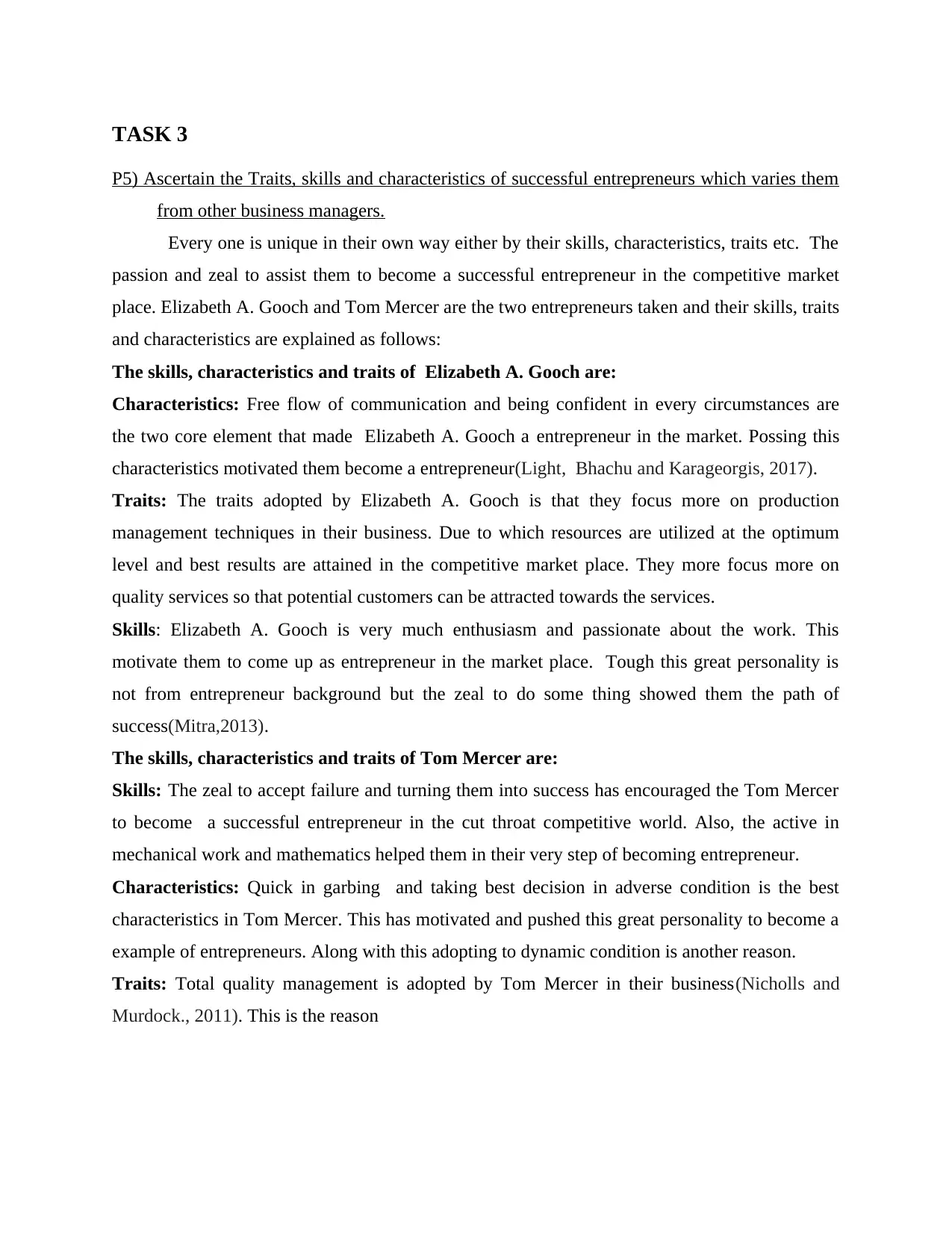
TASK 3
P5) Ascertain the Traits, skills and characteristics of successful entrepreneurs which varies them
from other business managers.
Every one is unique in their own way either by their skills, characteristics, traits etc. The
passion and zeal to assist them to become a successful entrepreneur in the competitive market
place. Elizabeth A. Gooch and Tom Mercer are the two entrepreneurs taken and their skills, traits
and characteristics are explained as follows:
The skills, characteristics and traits of Elizabeth A. Gooch are:
Characteristics: Free flow of communication and being confident in every circumstances are
the two core element that made Elizabeth A. Gooch a entrepreneur in the market. Possing this
characteristics motivated them become a entrepreneur(Light, Bhachu and Karageorgis, 2017).
Traits: The traits adopted by Elizabeth A. Gooch is that they focus more on production
management techniques in their business. Due to which resources are utilized at the optimum
level and best results are attained in the competitive market place. They more focus more on
quality services so that potential customers can be attracted towards the services.
Skills: Elizabeth A. Gooch is very much enthusiasm and passionate about the work. This
motivate them to come up as entrepreneur in the market place. Tough this great personality is
not from entrepreneur background but the zeal to do some thing showed them the path of
success(Mitra,2013).
The skills, characteristics and traits of Tom Mercer are:
Skills: The zeal to accept failure and turning them into success has encouraged the Tom Mercer
to become a successful entrepreneur in the cut throat competitive world. Also, the active in
mechanical work and mathematics helped them in their very step of becoming entrepreneur.
Characteristics: Quick in garbing and taking best decision in adverse condition is the best
characteristics in Tom Mercer. This has motivated and pushed this great personality to become a
example of entrepreneurs. Along with this adopting to dynamic condition is another reason.
Traits: Total quality management is adopted by Tom Mercer in their business(Nicholls and
Murdock., 2011). This is the reason
P5) Ascertain the Traits, skills and characteristics of successful entrepreneurs which varies them
from other business managers.
Every one is unique in their own way either by their skills, characteristics, traits etc. The
passion and zeal to assist them to become a successful entrepreneur in the competitive market
place. Elizabeth A. Gooch and Tom Mercer are the two entrepreneurs taken and their skills, traits
and characteristics are explained as follows:
The skills, characteristics and traits of Elizabeth A. Gooch are:
Characteristics: Free flow of communication and being confident in every circumstances are
the two core element that made Elizabeth A. Gooch a entrepreneur in the market. Possing this
characteristics motivated them become a entrepreneur(Light, Bhachu and Karageorgis, 2017).
Traits: The traits adopted by Elizabeth A. Gooch is that they focus more on production
management techniques in their business. Due to which resources are utilized at the optimum
level and best results are attained in the competitive market place. They more focus more on
quality services so that potential customers can be attracted towards the services.
Skills: Elizabeth A. Gooch is very much enthusiasm and passionate about the work. This
motivate them to come up as entrepreneur in the market place. Tough this great personality is
not from entrepreneur background but the zeal to do some thing showed them the path of
success(Mitra,2013).
The skills, characteristics and traits of Tom Mercer are:
Skills: The zeal to accept failure and turning them into success has encouraged the Tom Mercer
to become a successful entrepreneur in the cut throat competitive world. Also, the active in
mechanical work and mathematics helped them in their very step of becoming entrepreneur.
Characteristics: Quick in garbing and taking best decision in adverse condition is the best
characteristics in Tom Mercer. This has motivated and pushed this great personality to become a
example of entrepreneurs. Along with this adopting to dynamic condition is another reason.
Traits: Total quality management is adopted by Tom Mercer in their business(Nicholls and
Murdock., 2011). This is the reason
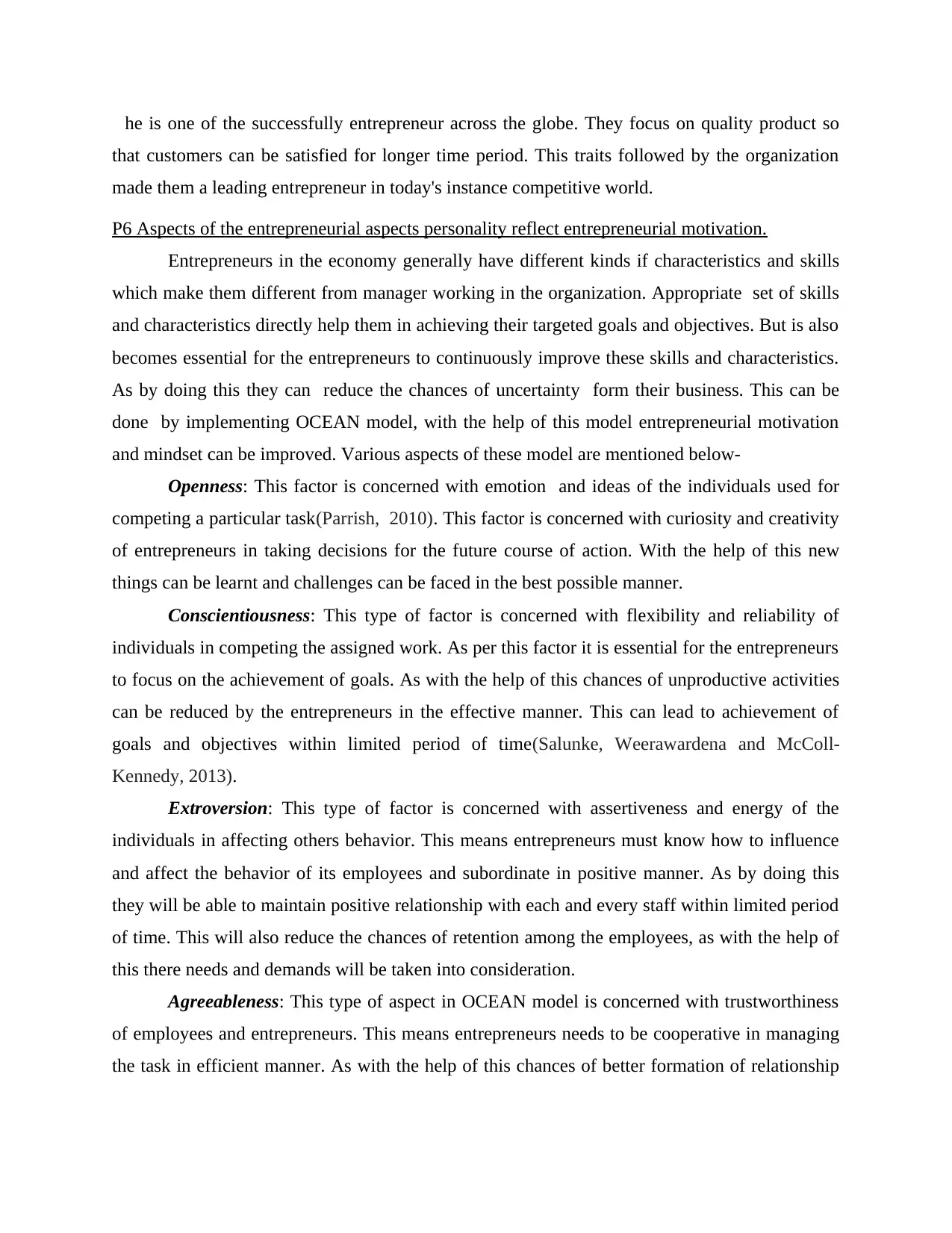
he is one of the successfully entrepreneur across the globe. They focus on quality product so
that customers can be satisfied for longer time period. This traits followed by the organization
made them a leading entrepreneur in today's instance competitive world.
P6 Aspects of the entrepreneurial aspects personality reflect entrepreneurial motivation.
Entrepreneurs in the economy generally have different kinds if characteristics and skills
which make them different from manager working in the organization. Appropriate set of skills
and characteristics directly help them in achieving their targeted goals and objectives. But is also
becomes essential for the entrepreneurs to continuously improve these skills and characteristics.
As by doing this they can reduce the chances of uncertainty form their business. This can be
done by implementing OCEAN model, with the help of this model entrepreneurial motivation
and mindset can be improved. Various aspects of these model are mentioned below-
Openness: This factor is concerned with emotion and ideas of the individuals used for
competing a particular task(Parrish, 2010). This factor is concerned with curiosity and creativity
of entrepreneurs in taking decisions for the future course of action. With the help of this new
things can be learnt and challenges can be faced in the best possible manner.
Conscientiousness: This type of factor is concerned with flexibility and reliability of
individuals in competing the assigned work. As per this factor it is essential for the entrepreneurs
to focus on the achievement of goals. As with the help of this chances of unproductive activities
can be reduced by the entrepreneurs in the effective manner. This can lead to achievement of
goals and objectives within limited period of time(Salunke, Weerawardena and McColl-
Kennedy, 2013).
Extroversion: This type of factor is concerned with assertiveness and energy of the
individuals in affecting others behavior. This means entrepreneurs must know how to influence
and affect the behavior of its employees and subordinate in positive manner. As by doing this
they will be able to maintain positive relationship with each and every staff within limited period
of time. This will also reduce the chances of retention among the employees, as with the help of
this there needs and demands will be taken into consideration.
Agreeableness: This type of aspect in OCEAN model is concerned with trustworthiness
of employees and entrepreneurs. This means entrepreneurs needs to be cooperative in managing
the task in efficient manner. As with the help of this chances of better formation of relationship
that customers can be satisfied for longer time period. This traits followed by the organization
made them a leading entrepreneur in today's instance competitive world.
P6 Aspects of the entrepreneurial aspects personality reflect entrepreneurial motivation.
Entrepreneurs in the economy generally have different kinds if characteristics and skills
which make them different from manager working in the organization. Appropriate set of skills
and characteristics directly help them in achieving their targeted goals and objectives. But is also
becomes essential for the entrepreneurs to continuously improve these skills and characteristics.
As by doing this they can reduce the chances of uncertainty form their business. This can be
done by implementing OCEAN model, with the help of this model entrepreneurial motivation
and mindset can be improved. Various aspects of these model are mentioned below-
Openness: This factor is concerned with emotion and ideas of the individuals used for
competing a particular task(Parrish, 2010). This factor is concerned with curiosity and creativity
of entrepreneurs in taking decisions for the future course of action. With the help of this new
things can be learnt and challenges can be faced in the best possible manner.
Conscientiousness: This type of factor is concerned with flexibility and reliability of
individuals in competing the assigned work. As per this factor it is essential for the entrepreneurs
to focus on the achievement of goals. As with the help of this chances of unproductive activities
can be reduced by the entrepreneurs in the effective manner. This can lead to achievement of
goals and objectives within limited period of time(Salunke, Weerawardena and McColl-
Kennedy, 2013).
Extroversion: This type of factor is concerned with assertiveness and energy of the
individuals in affecting others behavior. This means entrepreneurs must know how to influence
and affect the behavior of its employees and subordinate in positive manner. As by doing this
they will be able to maintain positive relationship with each and every staff within limited period
of time. This will also reduce the chances of retention among the employees, as with the help of
this there needs and demands will be taken into consideration.
Agreeableness: This type of aspect in OCEAN model is concerned with trustworthiness
of employees and entrepreneurs. This means entrepreneurs needs to be cooperative in managing
the task in efficient manner. As with the help of this chances of better formation of relationship
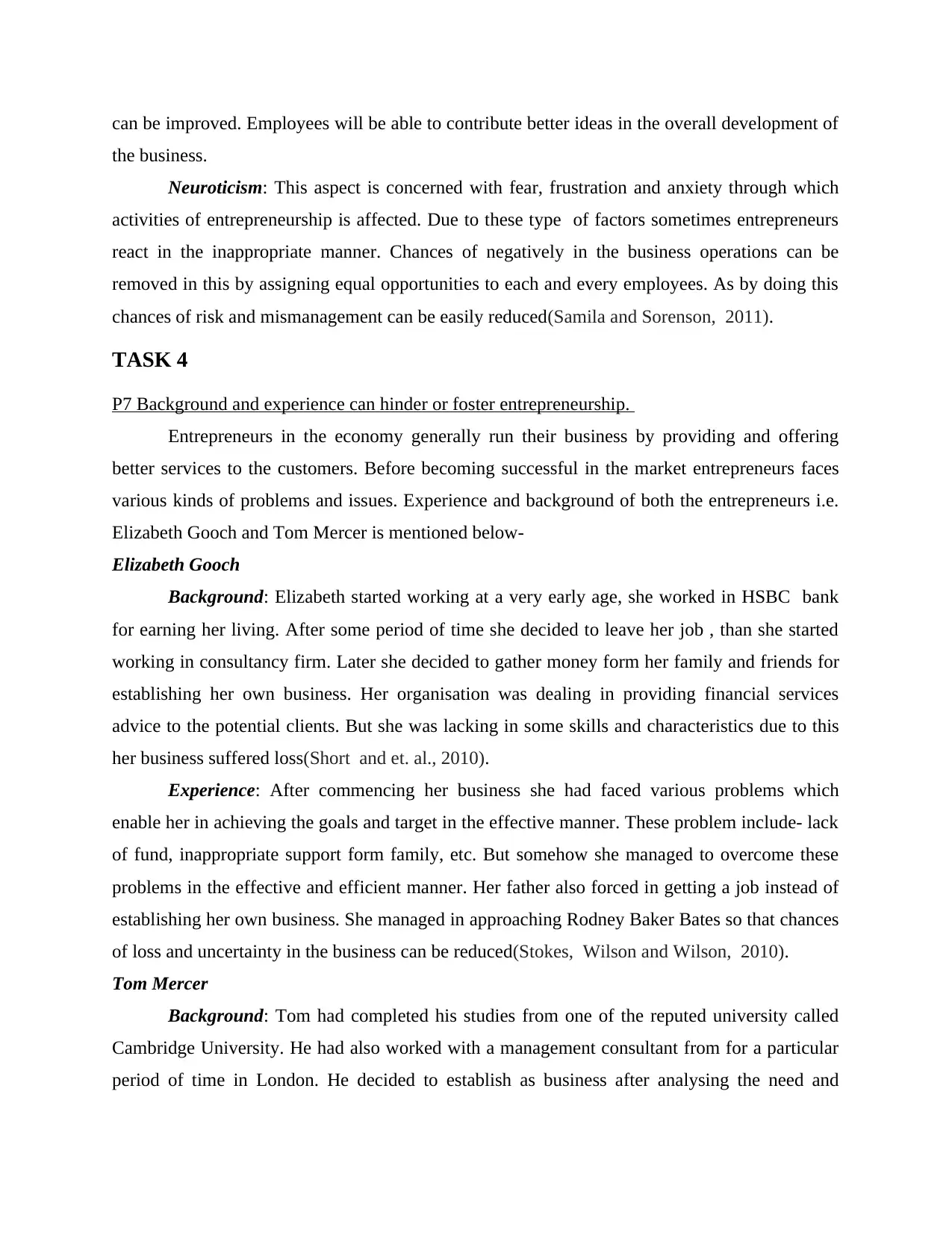
can be improved. Employees will be able to contribute better ideas in the overall development of
the business.
Neuroticism: This aspect is concerned with fear, frustration and anxiety through which
activities of entrepreneurship is affected. Due to these type of factors sometimes entrepreneurs
react in the inappropriate manner. Chances of negatively in the business operations can be
removed in this by assigning equal opportunities to each and every employees. As by doing this
chances of risk and mismanagement can be easily reduced(Samila and Sorenson, 2011).
TASK 4
P7 Background and experience can hinder or foster entrepreneurship.
Entrepreneurs in the economy generally run their business by providing and offering
better services to the customers. Before becoming successful in the market entrepreneurs faces
various kinds of problems and issues. Experience and background of both the entrepreneurs i.e.
Elizabeth Gooch and Tom Mercer is mentioned below-
Elizabeth Gooch
Background: Elizabeth started working at a very early age, she worked in HSBC bank
for earning her living. After some period of time she decided to leave her job , than she started
working in consultancy firm. Later she decided to gather money form her family and friends for
establishing her own business. Her organisation was dealing in providing financial services
advice to the potential clients. But she was lacking in some skills and characteristics due to this
her business suffered loss(Short and et. al., 2010).
Experience: After commencing her business she had faced various problems which
enable her in achieving the goals and target in the effective manner. These problem include- lack
of fund, inappropriate support form family, etc. But somehow she managed to overcome these
problems in the effective and efficient manner. Her father also forced in getting a job instead of
establishing her own business. She managed in approaching Rodney Baker Bates so that chances
of loss and uncertainty in the business can be reduced(Stokes, Wilson and Wilson, 2010).
Tom Mercer
Background: Tom had completed his studies from one of the reputed university called
Cambridge University. He had also worked with a management consultant from for a particular
period of time in London. He decided to establish as business after analysing the need and
the business.
Neuroticism: This aspect is concerned with fear, frustration and anxiety through which
activities of entrepreneurship is affected. Due to these type of factors sometimes entrepreneurs
react in the inappropriate manner. Chances of negatively in the business operations can be
removed in this by assigning equal opportunities to each and every employees. As by doing this
chances of risk and mismanagement can be easily reduced(Samila and Sorenson, 2011).
TASK 4
P7 Background and experience can hinder or foster entrepreneurship.
Entrepreneurs in the economy generally run their business by providing and offering
better services to the customers. Before becoming successful in the market entrepreneurs faces
various kinds of problems and issues. Experience and background of both the entrepreneurs i.e.
Elizabeth Gooch and Tom Mercer is mentioned below-
Elizabeth Gooch
Background: Elizabeth started working at a very early age, she worked in HSBC bank
for earning her living. After some period of time she decided to leave her job , than she started
working in consultancy firm. Later she decided to gather money form her family and friends for
establishing her own business. Her organisation was dealing in providing financial services
advice to the potential clients. But she was lacking in some skills and characteristics due to this
her business suffered loss(Short and et. al., 2010).
Experience: After commencing her business she had faced various problems which
enable her in achieving the goals and target in the effective manner. These problem include- lack
of fund, inappropriate support form family, etc. But somehow she managed to overcome these
problems in the effective and efficient manner. Her father also forced in getting a job instead of
establishing her own business. She managed in approaching Rodney Baker Bates so that chances
of loss and uncertainty in the business can be reduced(Stokes, Wilson and Wilson, 2010).
Tom Mercer
Background: Tom had completed his studies from one of the reputed university called
Cambridge University. He had also worked with a management consultant from for a particular
period of time in London. He decided to establish as business after analysing the need and
Secure Best Marks with AI Grader
Need help grading? Try our AI Grader for instant feedback on your assignments.
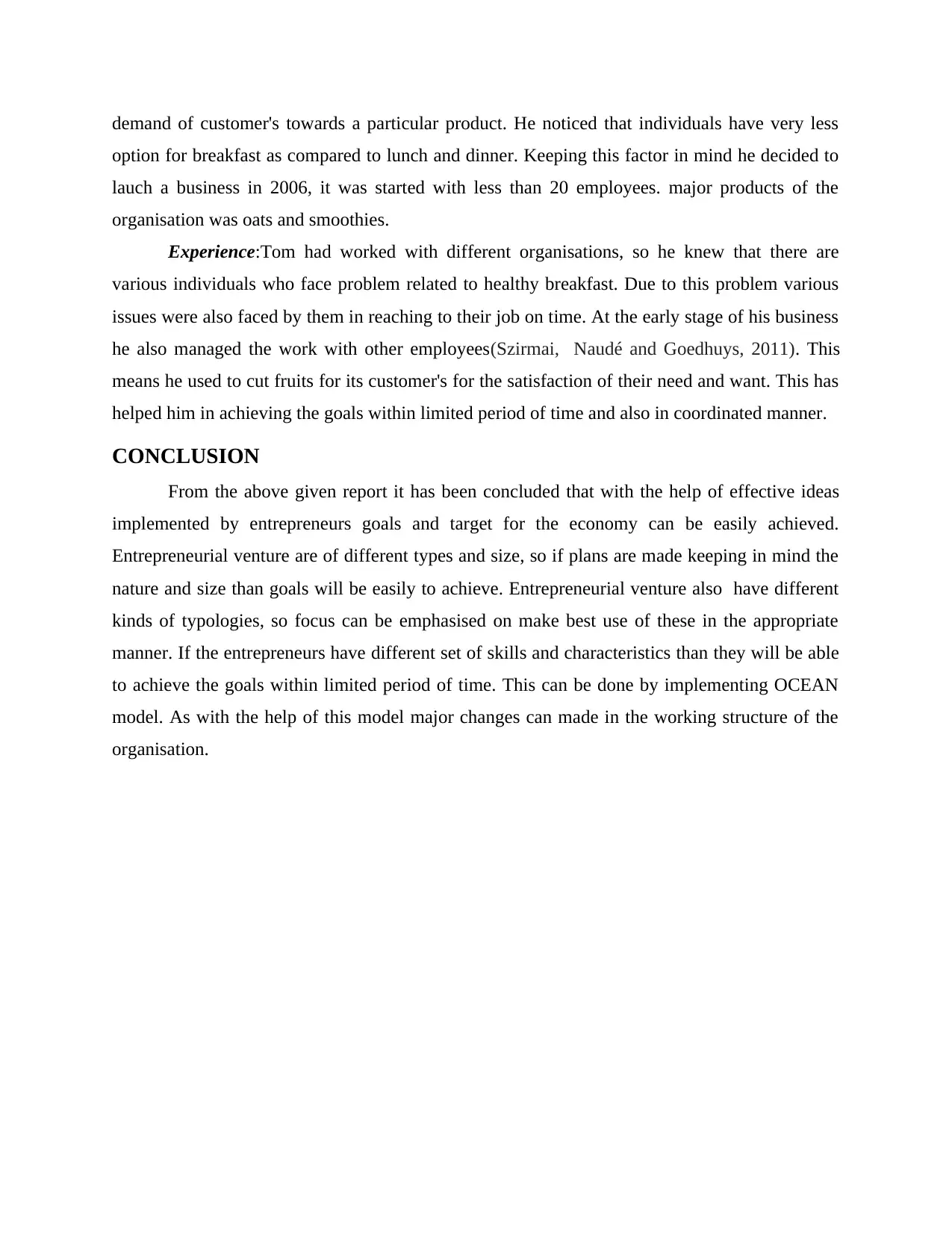
demand of customer's towards a particular product. He noticed that individuals have very less
option for breakfast as compared to lunch and dinner. Keeping this factor in mind he decided to
lauch a business in 2006, it was started with less than 20 employees. major products of the
organisation was oats and smoothies.
Experience:Tom had worked with different organisations, so he knew that there are
various individuals who face problem related to healthy breakfast. Due to this problem various
issues were also faced by them in reaching to their job on time. At the early stage of his business
he also managed the work with other employees(Szirmai, Naudé and Goedhuys, 2011). This
means he used to cut fruits for its customer's for the satisfaction of their need and want. This has
helped him in achieving the goals within limited period of time and also in coordinated manner.
CONCLUSION
From the above given report it has been concluded that with the help of effective ideas
implemented by entrepreneurs goals and target for the economy can be easily achieved.
Entrepreneurial venture are of different types and size, so if plans are made keeping in mind the
nature and size than goals will be easily to achieve. Entrepreneurial venture also have different
kinds of typologies, so focus can be emphasised on make best use of these in the appropriate
manner. If the entrepreneurs have different set of skills and characteristics than they will be able
to achieve the goals within limited period of time. This can be done by implementing OCEAN
model. As with the help of this model major changes can made in the working structure of the
organisation.
option for breakfast as compared to lunch and dinner. Keeping this factor in mind he decided to
lauch a business in 2006, it was started with less than 20 employees. major products of the
organisation was oats and smoothies.
Experience:Tom had worked with different organisations, so he knew that there are
various individuals who face problem related to healthy breakfast. Due to this problem various
issues were also faced by them in reaching to their job on time. At the early stage of his business
he also managed the work with other employees(Szirmai, Naudé and Goedhuys, 2011). This
means he used to cut fruits for its customer's for the satisfaction of their need and want. This has
helped him in achieving the goals within limited period of time and also in coordinated manner.
CONCLUSION
From the above given report it has been concluded that with the help of effective ideas
implemented by entrepreneurs goals and target for the economy can be easily achieved.
Entrepreneurial venture are of different types and size, so if plans are made keeping in mind the
nature and size than goals will be easily to achieve. Entrepreneurial venture also have different
kinds of typologies, so focus can be emphasised on make best use of these in the appropriate
manner. If the entrepreneurs have different set of skills and characteristics than they will be able
to achieve the goals within limited period of time. This can be done by implementing OCEAN
model. As with the help of this model major changes can made in the working structure of the
organisation.
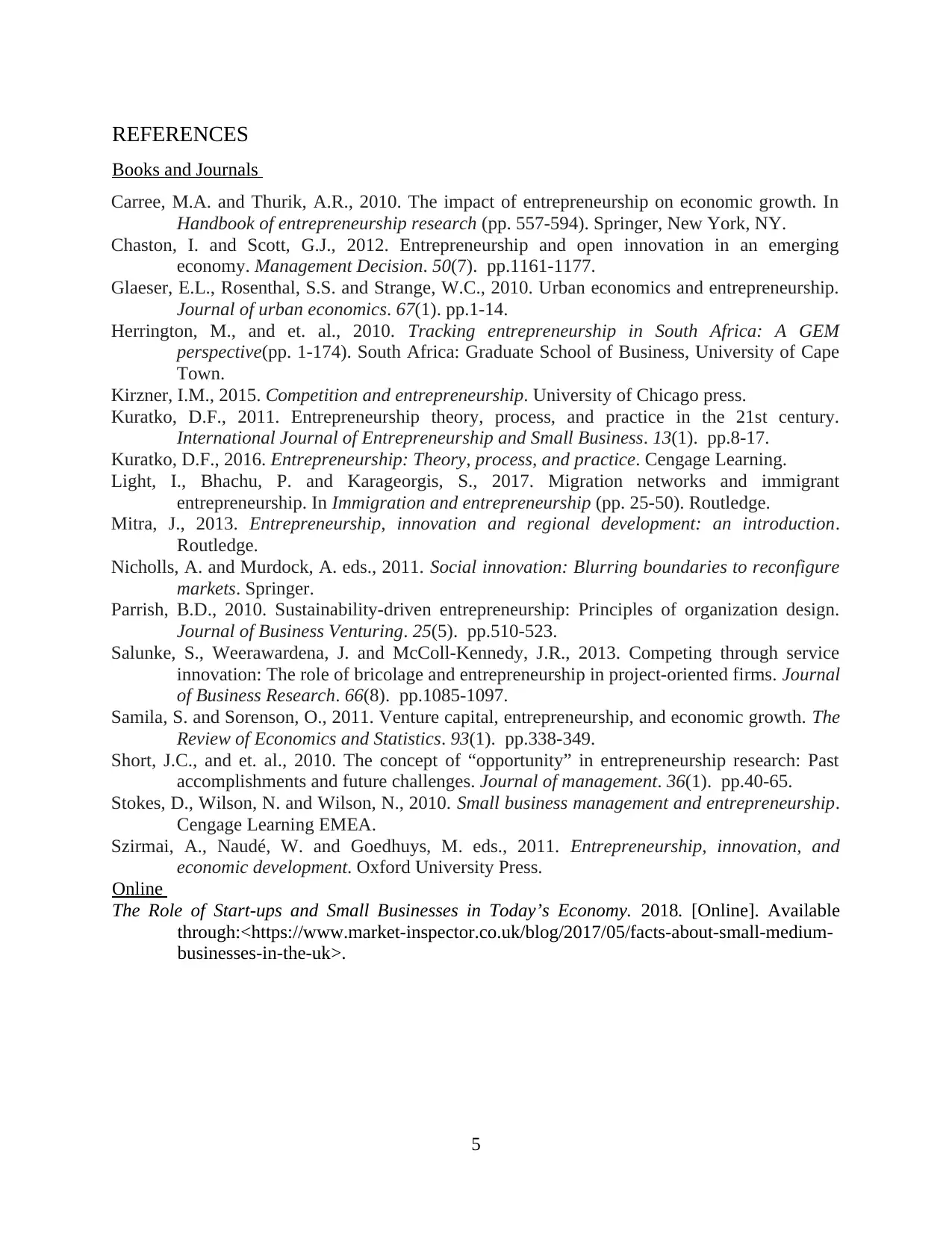
REFERENCES
Books and Journals
Carree, M.A. and Thurik, A.R., 2010. The impact of entrepreneurship on economic growth. In
Handbook of entrepreneurship research (pp. 557-594). Springer, New York, NY.
Chaston, I. and Scott, G.J., 2012. Entrepreneurship and open innovation in an emerging
economy. Management Decision. 50(7). pp.1161-1177.
Glaeser, E.L., Rosenthal, S.S. and Strange, W.C., 2010. Urban economics and entrepreneurship.
Journal of urban economics. 67(1). pp.1-14.
Herrington, M., and et. al., 2010. Tracking entrepreneurship in South Africa: A GEM
perspective(pp. 1-174). South Africa: Graduate School of Business, University of Cape
Town.
Kirzner, I.M., 2015. Competition and entrepreneurship. University of Chicago press.
Kuratko, D.F., 2011. Entrepreneurship theory, process, and practice in the 21st century.
International Journal of Entrepreneurship and Small Business. 13(1). pp.8-17.
Kuratko, D.F., 2016. Entrepreneurship: Theory, process, and practice. Cengage Learning.
Light, I., Bhachu, P. and Karageorgis, S., 2017. Migration networks and immigrant
entrepreneurship. In Immigration and entrepreneurship (pp. 25-50). Routledge.
Mitra, J., 2013. Entrepreneurship, innovation and regional development: an introduction.
Routledge.
Nicholls, A. and Murdock, A. eds., 2011. Social innovation: Blurring boundaries to reconfigure
markets. Springer.
Parrish, B.D., 2010. Sustainability-driven entrepreneurship: Principles of organization design.
Journal of Business Venturing. 25(5). pp.510-523.
Salunke, S., Weerawardena, J. and McColl-Kennedy, J.R., 2013. Competing through service
innovation: The role of bricolage and entrepreneurship in project-oriented firms. Journal
of Business Research. 66(8). pp.1085-1097.
Samila, S. and Sorenson, O., 2011. Venture capital, entrepreneurship, and economic growth. The
Review of Economics and Statistics. 93(1). pp.338-349.
Short, J.C., and et. al., 2010. The concept of “opportunity” in entrepreneurship research: Past
accomplishments and future challenges. Journal of management. 36(1). pp.40-65.
Stokes, D., Wilson, N. and Wilson, N., 2010. Small business management and entrepreneurship.
Cengage Learning EMEA.
Szirmai, A., Naudé, W. and Goedhuys, M. eds., 2011. Entrepreneurship, innovation, and
economic development. Oxford University Press.
Online
The Role of Start-ups and Small Businesses in Today’s Economy. 2018. [Online]. Available
through:<https://www.market-inspector.co.uk/blog/2017/05/facts-about-small-medium-
businesses-in-the-uk>.
5
Books and Journals
Carree, M.A. and Thurik, A.R., 2010. The impact of entrepreneurship on economic growth. In
Handbook of entrepreneurship research (pp. 557-594). Springer, New York, NY.
Chaston, I. and Scott, G.J., 2012. Entrepreneurship and open innovation in an emerging
economy. Management Decision. 50(7). pp.1161-1177.
Glaeser, E.L., Rosenthal, S.S. and Strange, W.C., 2010. Urban economics and entrepreneurship.
Journal of urban economics. 67(1). pp.1-14.
Herrington, M., and et. al., 2010. Tracking entrepreneurship in South Africa: A GEM
perspective(pp. 1-174). South Africa: Graduate School of Business, University of Cape
Town.
Kirzner, I.M., 2015. Competition and entrepreneurship. University of Chicago press.
Kuratko, D.F., 2011. Entrepreneurship theory, process, and practice in the 21st century.
International Journal of Entrepreneurship and Small Business. 13(1). pp.8-17.
Kuratko, D.F., 2016. Entrepreneurship: Theory, process, and practice. Cengage Learning.
Light, I., Bhachu, P. and Karageorgis, S., 2017. Migration networks and immigrant
entrepreneurship. In Immigration and entrepreneurship (pp. 25-50). Routledge.
Mitra, J., 2013. Entrepreneurship, innovation and regional development: an introduction.
Routledge.
Nicholls, A. and Murdock, A. eds., 2011. Social innovation: Blurring boundaries to reconfigure
markets. Springer.
Parrish, B.D., 2010. Sustainability-driven entrepreneurship: Principles of organization design.
Journal of Business Venturing. 25(5). pp.510-523.
Salunke, S., Weerawardena, J. and McColl-Kennedy, J.R., 2013. Competing through service
innovation: The role of bricolage and entrepreneurship in project-oriented firms. Journal
of Business Research. 66(8). pp.1085-1097.
Samila, S. and Sorenson, O., 2011. Venture capital, entrepreneurship, and economic growth. The
Review of Economics and Statistics. 93(1). pp.338-349.
Short, J.C., and et. al., 2010. The concept of “opportunity” in entrepreneurship research: Past
accomplishments and future challenges. Journal of management. 36(1). pp.40-65.
Stokes, D., Wilson, N. and Wilson, N., 2010. Small business management and entrepreneurship.
Cengage Learning EMEA.
Szirmai, A., Naudé, W. and Goedhuys, M. eds., 2011. Entrepreneurship, innovation, and
economic development. Oxford University Press.
Online
The Role of Start-ups and Small Businesses in Today’s Economy. 2018. [Online]. Available
through:<https://www.market-inspector.co.uk/blog/2017/05/facts-about-small-medium-
businesses-in-the-uk>.
5
1 out of 12
Related Documents
Your All-in-One AI-Powered Toolkit for Academic Success.
+13062052269
info@desklib.com
Available 24*7 on WhatsApp / Email
![[object Object]](/_next/static/media/star-bottom.7253800d.svg)
Unlock your academic potential
© 2024 | Zucol Services PVT LTD | All rights reserved.





